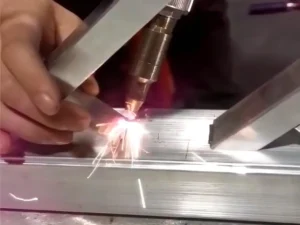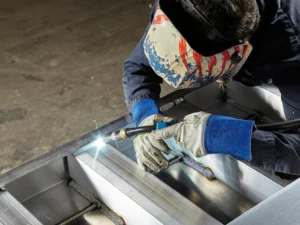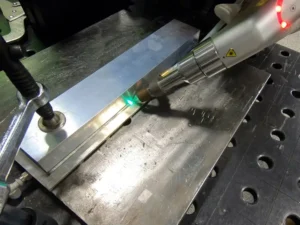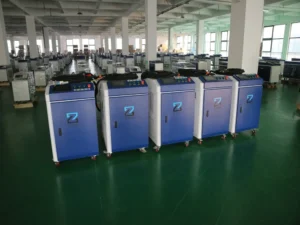Introduction:
Today, laser welding is a significant technology in manufacturing. It is beneficial for making aluminum components. The use and potential of joining aluminum structures have changed. It offers many benefits. Yet, it also presents unique challenges.
Let’s dive into the world of laser welding aluminum. We’ll explore the essential aspects.
The Importance of Laser Welding Aluminum
Laser welding aluminum is crucial for working with aluminum. It’s a super precise way to join aluminum parts together. Many industries rely on laser welding. These include airplanes, cars, gadgets, and green energy equipment. They all need strong, light materials.

Laser welding is excellent for making complex aluminum structures. It’s great for saving money and making better products. More industries want light and suitable materials. Laser welding will be even more critical.
Overview of How Laser Welding Works
Laser welding is a fancy way to stick metal together. Instead of using fire or electricity, it uses a powerful laser beam to melt the metal. This creates a strong bond between the pieces. Traditional welding methods rely on heat from electric arcs or flames. In contrast, laser welding offers superior control and accuracy. A high-energy laser beam melts the surface of aluminum workpieces. Laser welding creates strong and reliable bonds. Laser welding is precise and controllable. It is ideal for applications that need intricate designs and tight tolerances.
The Advantages Over Traditional Welding Methods
Clean and precise welds
Laser welding produces clean and precise welds. It also causes minimal distortion. This reduces the need for extra finishing processes.
Minimal heat-affected zones
Laser welding minimizes heat-affected zones. This results in less distortion and warping of the workpiece.
High welding speeds
Laser welding is faster than traditional welding methods. It increases productivity and reduces manufacturing costs.
Versatility
You can use laser welding to weld a wide range of materials. These include aluminum, stainless steel, and titanium. It is suitable for various applications. Different industries use it.
Challenges in Aluminum Laser Welding
Laser welding has many advantages. But, it also presents some challenges. This is especially true when welding aluminum.

High Reflectivity
Aluminum alloys have high reflectivity to laser light. This can result in spatter, porosity, or incomplete fusion. If not managed during welding.
Thermal Cracking
Welding thick aluminum materials can lead to thermal cracking. Rapid heating and cooling cause this. Proper control of welding parameters is essential. It prevents thermal cracking. It also ensures weld quality.
Porosity
Porosity, or tiny gas pockets in the weld, can weaken it and reduce its reliability. Proper surface preparation and choosing the right shielding gas are critical. This minimizes porosity in laser-welded aluminum joints.
Applications of Laser Welding Aluminum
People use laser welding in lots of ways.
In Aerospace and Aviation
The aerospace and aviation industries use laser welding. They use it to make lightweight aluminum components. It also enables repeatability. This ensures that planes and spacecraft are sound. It also ensures they perform well.
In Automotive Manufacturing
Automotive manufacturers use laser welding. They use it to join aluminum body panels. They also use it to join structural and chassis components. Laser welding offers excellent strength-to-weight ratios. It also offers corrosion resistance. This contributes to better fuel efficiency in modern vehicles. It also improves durability.
In the Electronics Industry
The electronics industry relies on laser welding. It produces tiny aluminum parts for smartphones, tablets, and other electronic devices. Laser welding enables precise and reliable joining of thin aluminum foils and substrates. This ensures the integrity and functionality of electronic assemblies.
In the Renewable Energy Sector
The renewable energy sector uses laser welding. It’s to fabricate aluminum components. They use it for solar panels and wind turbines. They also use it for other sustainable energy systems. Laser-welded aluminum structures offer superior durability. They also resist corrosion and save energy. This helps advance renewable energy technologies.
Types of Lasers for Aluminum Welding
People use several types of lasers to weld aluminum. Each type has its unique characteristics and advantages.

CO2 Lasers
CO2 lasers are powerful. They can penetrate thick aluminum materials. They are well-suited for heavy-duty welding tasks. This includes work in aerospace and automotive manufacturing.
YAG Lasers
YAG lasers have a reputation for their precision. They are ideal for welding small and intricate components. They create clean welds without causing any damage. This makes them ideal for electronics and medical devices.
Fiber Lasers
Fiber lasers are the newest addition to the laser welding scene. They are fast, energy-efficient, and versatile. This makes them suitable for various aluminum welding applications. It includes high-volume production.
Comparison of Their Characteristics
Each type of laser has its advantages and disadvantages for welding aluminum. CO2 lasers offer deep penetration. But, they may not be as precise as YAG lasers for intricate welding tasks. YAG lasers provide excellent precision. Yet, they may be slower than fiber lasers for high-volume production. Fiber lasers offer a good balance of speed, precision, and energy efficiency. They are suitable for a wide range of aluminum welding applications.
Key Parameters when choosing a laser welder for aluminum
Consider several key parameters to achieve the best weld quality when choosing a aluminum laser welder.

Laser parameters
Laser power, pulse duration, and beam focus influence weld penetration. It also affects heat input and weld quality.
Shielding gas
Proper selection of shielding gas and flow rate is essential. This prevents oxidation. It also minimizes porosity in the weld zone.
Travel speed
The speed of the laser affects heat input, weld penetration, and productivity.
Techniques to Improve Weld Quality
You can use several techniques to improve weld quality. You can also reduce defects in laser-welded aluminum joints.
Pre-weld treatment
Proper surface cleaning and preparation help remove contaminants. They also ensure good weldability.
Parameter optimization
You can adjust laser parameters to optimize weld penetration and reduce defects. For example, you can adjust power, pulse duration, and focus. Double-point welding uses two laser beams. It can improve weld quality and productivity. This is especially true for thicker materials. Fiber lasers offer superior beam quality, control, and energy efficiency. They produce high-quality welds with minimal heat input.
Conclusion:
Laser welding aluminum is a key technology in modern manufacturing. It offers precision, efficiency, and versatility. Laser welding is revolutionizing the manufacturing process. It’s for lightweight and durable aluminum structures.
This is true. It holds even after aluminum’s high reflectivity and thermal conductivity. Manufacturers can use the potential of this transformative technology. They need to understand the importance of laser welding aluminum. They can do this by using best practices and techniques. Laser welding is a big deal in making stuff nowadays. It’s super helpful in creating parts from aluminum. It’s got a lot of good things going for it, but also some tricky bits. We all know that it will develop more with time. Thus, it is all about laser welding aluminum.
